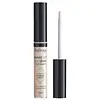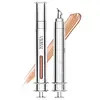What's inside
What's inside
 Key Ingredients
Key Ingredients

No key ingredients
 Benefits
Benefits

 Concerns
Concerns

No concerns
 Ingredients Side-by-side
Ingredients Side-by-side

Water
Skin ConditioningSqualane
EmollientHydrogenated Polydecene
EmollientPropanediol
SolventGlycerin
HumectantHydrogenated Didecene
Skin ConditioningPolyglyceryl-4 Isostearate
EmulsifyingMethylpropanediol
SolventDisteardimonium Hectorite
StabilisingMagnesium Sulfate
Propylene Carbonate
SolventCaprylyl Glycol
EmollientPotassium Sorbate
PreservativeSodium Dehydroacetate
PreservativeEvodia Rutaecarpa Fruit Extract
Skin ConditioningAluminum Hydroxide
EmollientPhenylpropanol
MaskingSodium Lauroyl Glutamate
Lysine
Skin ConditioningMagnesium Chloride
CI 77891
Cosmetic ColorantCI 77492
Cosmetic ColorantCI 77163
Cosmetic ColorantCI 77491
Cosmetic ColorantCI 77499
Cosmetic ColorantWater, Squalane, Hydrogenated Polydecene, Propanediol, Glycerin, Hydrogenated Didecene, Polyglyceryl-4 Isostearate, Methylpropanediol, Disteardimonium Hectorite, Magnesium Sulfate, Propylene Carbonate, Caprylyl Glycol, Potassium Sorbate, Sodium Dehydroacetate, Evodia Rutaecarpa Fruit Extract, Aluminum Hydroxide, Phenylpropanol, Sodium Lauroyl Glutamate, Lysine, Magnesium Chloride, CI 77891, CI 77492, CI 77163, CI 77491, CI 77499
Water
Skin ConditioningC13-15 Alkane
SolventTriolein
Skin ConditioningButylene Glycol
HumectantIsopentyldiol
HumectantSqualane
EmollientGlyceryl Dioleate
EmollientPolyglyceryl-3 Polyricinoleate
EmulsifyingMethylpropanediol
SolventDisteardimonium Hectorite
StabilisingHydrogenated Polydecene
EmollientMica
Cosmetic ColorantGlyceryl Oleate Citrate
EmulsifyingPolyglyceryl-3 Diisostearate
EmulsifyingTriheptanoin
Skin ConditioningSodium Chloride
MaskingCaffeine
Skin ConditioningPolyhydroxystearic Acid
EmulsifyingCaprylyl Glycol
EmollientSilica
AbrasiveTrisodium Ethylenediamine Disuccinate
Phenylpropanol
MaskingAluminum Hydroxide
EmollientFucus Vesiculosus Extract
EmollientSodium Lauroyl Glutamate
Lysine
Skin ConditioningMagnesium Chloride
Gluconolactone
Skin ConditioningXanthan Gum
EmulsifyingSodium Benzoate
MaskingCI 77891
Cosmetic ColorantCI 77491
Cosmetic ColorantCI 77492
Cosmetic ColorantCI 77499
Cosmetic ColorantWater, C13-15 Alkane, Triolein, Butylene Glycol, Isopentyldiol, Squalane, Glyceryl Dioleate, Polyglyceryl-3 Polyricinoleate, Methylpropanediol, Disteardimonium Hectorite, Hydrogenated Polydecene, Mica, Glyceryl Oleate Citrate, Polyglyceryl-3 Diisostearate, Triheptanoin, Sodium Chloride, Caffeine, Polyhydroxystearic Acid, Caprylyl Glycol, Silica, Trisodium Ethylenediamine Disuccinate, Phenylpropanol, Aluminum Hydroxide, Fucus Vesiculosus Extract, Sodium Lauroyl Glutamate, Lysine, Magnesium Chloride, Gluconolactone, Xanthan Gum, Sodium Benzoate, CI 77891, CI 77491, CI 77492, CI 77499
Ingredients Explained
These ingredients are found in both products.
Ingredients higher up in an ingredient list are typically present in a larger amount.
Aluminum Hydroxide is a form of aluminum. It can be naturally found in nature as the mineral gibbsite. In cosmetics, Aluminum Hydroxide is used as a colorant, pH adjuster, and absorbent.
As a colorant, Aluminum Hydroxide may add opacity, or reduce the transparency. Aluminum hydroxide is contains both basic and acidic properties.
According to manufacturers, this ingredient is an emollient and humectant. This means it helps hydrate the skin.
In medicine, this ingredient is used to help relieve heartburn and help heal ulcers.
There is currently no credible scientific evidence linking aluminum hydroxide in cosmetics to increased cancer risk.
Major health organizations allow the use of aluminum hydroxide in personal care products and have not flagged it as a carcinogenic risk at typical usage levels.
Learn more about Aluminum HydroxideCaprylyl Glycol is a humectant and emollient, meaning it attracts and preserves moisture.
It is a common ingredient in many products, especially those designed to hydrate skin. The primary benefits are retaining moisture, skin softening, and promoting a healthy skin barrier.
Though Caprylyl Glycol is an alcohol derived from fatty acids, it is not the kind that can dry out skin.
This ingredient is also used as a preservative to extend the life of products. It has slight antimicrobial properties.
Learn more about Caprylyl GlycolCi 77491 is also hydrated iron III oxide. It's sole purpose is to give a red/pink hue to products.
Iron III oxides are classified as inorganic chemicals for coloring.
Synthetically created Ci 77491 is considered safer than those naturally found. This is because the synthetically created version may contain less impurities. Iron oxides are generally non-toxic and non-allergenic.
Learn more about CI 77491Ci 77492 is also hydrated iron III oxide. It's sole purpose is to give a yellow hue to products.
Iron III oxides are classified as inorganic chemicals for coloring.
Synthetically created Ci 77492 is considered safer than those naturally found. This is because the synthetically created version may contain less impurities. Iron oxides are generally non-toxic and non-allergenic.
Learn more about CI 77492Ci 77499 is also hydrated iron III oxide. It is created from mixing red and black iron oxides. This helps give shades of darkness to a product.
Iron III oxides are classified as inorganic chemicals for coloring.
Ci 77891 is a white pigment from Titanium dioxide. It is naturally found in minerals such as rutile and ilmenite.
It's main function is to add a white color to cosmetics. It can also be mixed with other colors to create different shades.
Ci 77891 is commonly found in sunscreens due to its ability to block UV rays.
Learn more about CI 77891Disteardimonium Hectorite comes from the clay mineral named hectorite. It is used to add thickness to a product.
It can also help stabilize a product by helping to disperse other ingredients.
Hectorite is a rare, white clay mineral.
Learn more about Disteardimonium HectoriteHydrogenated Polydecene is an emollient. It creates a non-occlusive film on the skin that offers extra protection for your skin barrier.
The texture of Hydrogenated Polydecene ranges from light and silky to rich.
Hydrogenated Polydecene is the end compound of controlled hydrogenation of Polydecene.
Learn more about Hydrogenated PolydeceneLysine is an essential amino acid. Your body is unable to produce it naturally and we mainly get lysine from food sources.
Our bodies use lysine for growth and tissue repair. The skin uses amino acids as a precursor for building protein, and therefore keratins, collagen and elastin.
We don't have a description for Magnesium Chloride yet.
Methylpropanediol is a synthetic solvent and humectant.
As a solvent, it helps dissolve other ingredients, helping to evenly distribute ingredients throughout the product. This ingredient has also been shown to have antimicrobial properties which makes it a preservative booster.
Methylpropanediol is able to add a bit of moisture to the skin. It also helps other ingredients be better absorbed into the skin, such as salicylic acid.
Learn more about MethylpropanediolPhenylpropanol is a fragrance.
Sodium Lauroyl Glutamate is the sodium salt from the lauric acid of glutamic acid.
It is a surfactant and helps cleanse the skin. Surfactants gather oil, dirt, and other pollutants from your skin so they may be washed away easily.
Squalane is an emollient that helps the skin hold onto moisture. It's an oily liquid that occurs naturally in certain types of fish and plant oils.
Because squalane boosts hydration in the skin, it also comes with plenty of benefits: it is an antioxidant and can help fight free radicals and skin damage. Squalane is also found to have a detoxifying effect when applied.
Squalane comes from squalene, which occurs naturally within the sebum of our skin. It is one of the oils our skin produces to keep itself hydrated. Squalane is the hydrogenated version of squalene and has a longer shelf life.
Research shows that squalane is non-irritating (even at 100% concentration).
In general, it's a fantastic ingredient. It does a great job at hydrating the skin, and it's suitable for those with sensitive skin.
The source of squalane may impact malassezia / fungal acne. This is because olive oil derived squalane can contain impurities such as fatty acids and plant waxes. Sugarcane derived squalane is recommended for anyone with malassezia concerns.
Is squalane vegan?
This depends on the source. Squalane can be derived from both plants and animals. Most squalane used in skincare comes from plants.
Please note: the source of squalane is only known if disclosed by the brand. We recommend reaching out to the brand if you have any questions about their squalane.
Read more about squalene with an "e".
Is squalane an oil?
Squalane is often called an oil, but it’s technically not; it’s a hydrocarbon, meaning it’s only made of carbon and hydrogen, unlike true oils which are triglycerides made of fatty acids and glycerol.
The term “oil-free” isn’t regulated, so companies can define it however they want. Some exclude all oils, while others just avoid mineral oil or comedogenic oils.
While some people avoid oils thinking they cause breakouts, the right kind of oil (or oil-like ingredient like squalane) can actually help balance and hydrate your skin. It’s worth testing out simple oils or squalane to see what works best for your skin.
Learn more about SqualaneWater. It's the most common cosmetic ingredient of all. You'll usually see it at the top of ingredient lists, meaning that it makes up the largest part of the product.
So why is it so popular? Water most often acts as a solvent - this means that it helps dissolve other ingredients into the formulation.
You'll also recognize water as that liquid we all need to stay alive. If you see this, drink a glass of water. Stay hydrated!
Learn more about Water